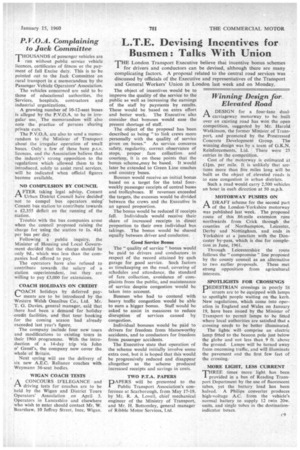Winning Design for • Elevated Road
Page 47

If you've noticed an error in this article please click here to report it so we can fix it.
PAA . DESIGN for a four-lane dualcarriageway motorway to be built over an existing road has won the open competition, suggested by Mr. Harold Watkinson, the former Minister of Transport, and promoted by the Prestressed Concrete Development Group. The winning design was by a team of G.K.N. Reinforcements, Ltd. There were 25 entries in the competition.
Cost of the motorway is estitnated at flint per mile. It is unlikely that sections more than five miles long will be built as the object of elevated roads is to ease congestion in urban districts.
Such a road would carry 2,500 vehicles an hour in each direction at 50 m.p.h.
MOTORWAY PUSHES ON
ADRAFT scheme for the second part of the London-Yorkshire motorway was published last week: The proposed route of this 86-mile extension runs northwards from Crick through the counties of Northampton, Leicester, Derby and Nottingham,' and ends in Yorkshire at a junction with the Doncaster by-pass, which is due for completion in June, 1961. •
Through Leicestershire the route follows the "compromise" line proposed by the county council as an alternative to two earlier proposals. These met strong opposition from agricultural interests.
SPOTLIGHTS FOR CROSSINGS
PEDESTRIAN crossings in poorly lit I streets are to be equipped with lamps to spotlight people waiting on the kerb. New regulations, which come into operation in England and Wales on January 19, have been issued by the Minister of Transport to permit lamps to be fitted where local authorities are satisfied that a crossing needs to be better illuminated.
The lights willcomprise an electric lamp fitted to the beacon pole just below the globe and not less than 9 ft. above the ground. Lamas will be turned away from oncoming traffic, and will illuminate the pavement and the first few feet of the crossing.
MORE LIGHT, LESS CURRENT THREE times more light has been provided in a bus of Reading Transport Department by the use of fluorescent tubes, yet the battery load has been_ halved. A Philips converter produces high-voltage A.C. from the vehicle's normal battery to supply 12 twin 20w. units, and single tubes in the destinationindicator boxes.












































































































